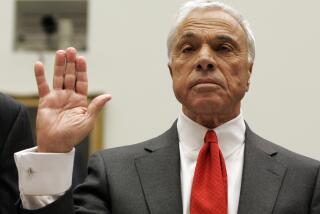Best-Run S&Ls; Have Set Own Paths to Success
Financial analysts lavish them with attention and bathe their chief executives in kind words because they are awash in money. Together, they earned $583 million in 1985.
But, far from being alike, the parent companies of Home Savings of America, Great Western Savings and World Savings have followed distinctly different paths since the heavy losses of the early 1980s forced the entire industry to rethink its future.
What they have in common are operations that have become nationwide and an aversion to the risk of long-term, fixed-rate loans. What separates them are management styles and divergent views about where savings and loans should invest their money.
Golden West Financial
Golden West Financial, Worldâs parent, is arguably the most unusual of the three, and that is so only partly because its top two executives are married to each other.
Herbert Sandler is the chairman of Golden West; his wife, Marion, is president. Both hold the title of chief executive. She was a thrift industry financial analyst and he a New York attorney before they bought control of the S&L; 23 years ago, when it had $34 million in assets.
Golden West has a decidedly anti-bureaucratic bent that reflects the Sandlersâ deep involvement in operations and large stake in the firm. Together they own more than 15% of Golden Westâs stock, the firmâs latest proxy statement shows.
âThey live and breathe that company,â said Allan Bortel, financial analyst for Shearson Lehman Bros.
The Sandlersâ formula, which resulted in 1985 profits of $160 million, keeps lending simple, costs down and risk to a minimum. Assets consist largely of mortgage loans and mortgage-backed securities.
As Marion Sandler puts it: âThere are no rewards for being first.â
They have cut costs by keeping the headquarters staff to a minimum and by hiring more than 600 part-time employees to help staff branch offices during peak hours. The Oakland headquarters does not even have a receptionist, only a black telephone in the lobby so visitors can call the switchboard.
They also have no public relations staff to deal with outsiders and write their annual reports. And, because he doesnât hire people to filter his remarks, Herbert Sandler makes public statements that most of his colleagues would utter only privately.
Golden Westâs 1985 annual report, for example, was critical of regulatory supervision and blunt about the health of the savings and loan industry.
So many savings and loans are in poor financial condition that âone might call (them) the walking dead,â Sandler was quoted as saying in an excerpt from an interview reproduced in the annual report. âThey exist in name only. Their losses, when recognized, will be greater than their net worth. There are hundreds and hundreds of them, in all sizes.â
Great Western Financial
Great Western Financial, meanwhile, has carved out a niche as a well-managed company that has both diversified and increased its volume of mortgage lending. Great Western is also very much identified with its chief executive, James Montgomery, who is regularly chosen as the thrift industryâs most able executive by the Wall Street Transcript newspaper.
Although Great Western Financial has acquired several companies in recent years, its major catch was a nationwide consumer finance and insurance company named Aristar that it bought for $165 million in 1983.
Aristar accounted for 12% of Great Western Financialâs first-quarter profits, and its chief executive, Robert P. Holmes, is now the No. 2 man in the parent company behind Montgomery.
On the other hand, Great Western also acquired a money-losing real estate brokerage and has an equipment-leasing company that is not making much money. One analyst, who asked not to be identified, termed those âbonehead movesâ but added that they are not âbig enough to make any difference.â The company made $202 million last year.
H. F. Ahmanson
No big S&L; has remained more of a pure adjustable-rate mortgage lender than Home Savings of America, whose parent company is H. F. Ahmanson. At the same time, the thrift company has gone national by buying ailing thrifts in six other states.
âWe have the simplest operations for a savings and loan,â said H. F. Ahmanson Chief Executive Richard Deihl. âWhat we have done is expand geographically.â
While others diversified, H. F. Ahmanson has cut back. The company took a charge of $5.6 million last year to cover the cost of discontinuing most of its property and liability insurance operations.
Yet Ahmansonâs earnings in 1985 grew to $221 million, four times what they were in 1984. Dean Witter Reynolds financial analyst Jerome Gitt estimated that Ahmanson will earn $294 million in 1986 and $318 million in 1987 if interest rates remain stable.
âThey were previously viewed as stodgy and sleepy, but they have come on like tigers in recent years,â Shearson Lehmanâs Bortel added.
Analysts credit Home Savings with creating an adjustable-rate mortgage loan that is both profitable for the company and acceptable to the consumer--a tricky proposition today, when falling interest rates have ballooned the popularity of fixed-rate mortgages.
Home Savings plans to make up to $10 billion worth of adjustable-rate mortgage loans this year, many of which will be sold in the secondary market to other investors.
âWe havenât made a fixed-rate mortgage since the end of 1981,â Deihl bragged.
Perhaps not, but Deihl said he recently obtained a 9.5% fixed-rate loan from an unnamed financial institution for a condominium that he bought in Los Angeles. It was a deal, he said, that was too good to turn down.
âI canât believe,â he says, his voice a mixture of wonder and disdain, âsomeone would give me a fixed-rate loan at 9 1/2%.â
More to Read
Inside the business of entertainment
The Wide Shot brings you news, analysis and insights on everything from streaming wars to production â and what it all means for the future.
You may occasionally receive promotional content from the Los Angeles Times.










